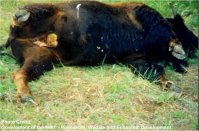|
|
| |
| Causative Agent |
-
A
zoonotic disease caused by infection
with the
bacteria
Bacillus anthracis.
-
B. anthracis
bacteria are highly effective at
causing disease because of several factors:
-
highly resistant, infectious
spores that are capable of
surviving outside of the host may be produced;
-
toxins are released in the
blood of the host organism while the
bacteria are undergoing rapid
reproduction.
-
Anthrax is highly infectious
to humans.
|
| Images |
|
Click on image to enlarge. |
 |
|
Bison killed by anthrax are
often found on their back or side with their legs in a
"saw-horse position". |
|
| Distribution |
|
Geographic: |
-
Worldwide distribution; may be common in specific geographic locations.
-
In Canadian wildlife, anthrax has been reported in wood bison (Bison
bison athabascae) in the Northwest Territories and in
northeastern Alberta.
|
|
Seasonality: |
-
May occur throughout the year, but most often in the late summer.
|
|
| Hosts, Transmission and Life
Cycle |
| Hosts: |
-
Mammalian herbivores have a higher susceptibility to anthrax than
carnivores, likely due to a more effective response from the
immune system of carnivores.
-
Wild mammals in North
America that have been confirmed to be susceptible to
anthrax include:
-
wood bison;
-
white-tailed deer (Odocoileus
virginianus);
-
moose (Alces
alces);
-
bobcat (Lynx
rufus);
-
cougar (Felis
concolor);
-
raccoon (Procyon
lotor);
-
mink (Mustela
vison).
-
Humans are also susceptible
to anthrax.
|
|
Transmission: |
-
Transmission in wildlife and in humans occurs in one of three ways:
-
cuts in the skin
(cutaneous)
-
inhalation;
-
ingestion;
-
Infected animals as well as
carriers of the disease can shed
spores in urine and feces.
-
In wildlife, anthrax
outbreaks typically occur in dry summers following periods
of rain.
-
Dry weather usually forces
grazing animals to feed closer to the ground where
spores are often concentrated.
Exposure typically occurs through inhalation or ingestion of
spore-laden dust.
-
Transmission among
susceptible animals may also occur through flies and
mosquitoes.
-
Humans can contract anthrax
from contact with infected animals through either:
-
cuts or scratches in the
skin;
-
the eyes, nose or mouth;
-
inhaling
spores from contaminated objects
such as hides of infected animals;
-
eating undercooked meat from
an infected animal.
|
|
Life Cycle: |
-
The oxygen and nutrient-rich blood of warm-blooded hosts represent ideal
conditions for anthrax
bacteria, and other types of
bacteria within the host are
outcompeted by anthrax
bacteria for resources.
-
When a host dies and oxygen
is no longer transported in the blood, B. anthracis
bacteria become dormant.
-
Other types of
bacteria from the
gastrointestinal tract of the host animal begin the process of decomposition and can destroy
remaining B. anthracis
bacteria if the carcass remains
intact.
-
Scavenging birds and mammals
may open the carcass, dispersing anthrax
bacteria which, given the correct
environmental conditions, form
spores that are infectious to
other animals or humans.
|
|
| Signs and Symptoms |
|
Animals: |
-
Within hours or days after exposure, infected animals may show signs of
fever, debilitation, breathing difficulties, disorientation,
and ultimately death.
-
Toxins produced by
bacteria in the blood are
transported throughout the body. These toxins cause a
reduction in oxygen in the blood,
edema, kidney failure,
shock, and ultimately death.
-
A frothy discharge may be
observed from the nose in addition to bloody discharges from
other body orifices.
|
|
Humans: |
-
Signs of
gastrointestinal
(ingestion) anthrax include:
-
fever, loss of appetite, vomiting and diarrhea.
-
Signs of
inhalation anthrax include:
-
fever, sore throat and
general ill-feeling that may be followed by breathing
difficulties; this is the most serious type of anthrax
infection.
-
Signs of cutaneous (skin) anthrax include:
-
a small painless bump that
often appears on the skin, which becomes a blister and
then an
ulcer with a black centre. In
humans, this is the most common type of anthrax
infection and can be treated with antibiotics.
|
|
| Meat Edible? |
-
Meat from infected animals should not be consumed or fed to dogs.
Carcasses should not be opened or otherwise cut into.
|
| Human Health Concerns and
Risk Reduction |
-
Anthrax is a potentially fatal
zoonotic disease; all appropriate
precautions should be taken to avoid exposure.
-
The carcass of a dead animal
suspected of having anthrax SHOULD NOT
BE OPENED OR TOUCHED! Wild bison are the most likely to
harbor anthrax; however, cattle are occasionally reported as well.
-
REPORT ANY SUSPECTED CASES OF ANTHRAX TO THE NEAREST CONSERVATION
OFFICER OR HEALTH AUTHORITY.
-
For further information on
human health concerns and anthrax, please refer to anthrax
information provided visit the websites of the
Canadian Food Inspection Agency or
US Centres for Disease Control and Prevention and follow the appropriate
links.
-
Anthrax is a
reportable disease in Canada, and under the Health of Animals Act, all cases must
be reported to the Canadian Food Inspection Agency (CFIA).
|
| Further Reading |
|
|
|
|




